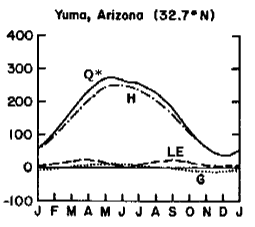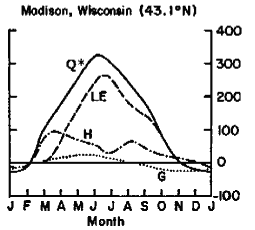 Digging Deeper: Local Energy Balances
Digging Deeper: Local Energy Balances
 Figure
4-c West Palm Beach, Fl energy balance (ly/day)
Figure
4-c West Palm Beach, Fl energy balance (ly/day)
West Palm Beach, Florida is located in the warm and moist tropical wet and dry (savanna) climate. The annual variation of net radiation shows a typical pattern of Q* being at a maximum during the summer and minimum during the winter. Latent heat transfer (LE) is high at West Palm Beach because of the water availability near the ocean. Latent energy transfer into the air is greatest during the summer time which is the wettest period of the year, and when net radiation is the highest. Warmer summer time air can hold more moisture and hence there is a larger moisture gradient to drive latent heat transfer. The annual variation of sensible heat transfer is determined by the available net radiation and the temperature gradient between the air and surface, as well as use of energy for latent heat transfer. During the spring a larger temperature gradient exists between the surface and the air above. Ample rainfall occurs during the summer providing water for evaporation. During this time period, sensible heat transfer decreases as net radiation is allocated to evaporation and latent heat transfer.
 Figure
4-d Yuma, AZ energy balance (ly/day)
Figure
4-d Yuma, AZ energy balance (ly/day)
At the other extreme is Yuma, Arizona, a warm and dry location typical of the midlatitude desert climate. The most noticeable characteristic of this place is the lack of latent heat transfer. Though ample radiation is available here, there is little water to evaporate. Nearly all net radiation is used for sensible heat transfer which explains the hot, dry conditions at Yuma.
Figure 4-e Madison, WI energy balance (ly/day)
Between these extremes is Madison, WI found in the humid continental climate of North America. Latent heat transfer dominates for most of the year in this humid climate. Sensible heat transfer is especially high when surface and air temperatures are most different. The transfer of energy in and out of the subsurface is a much greater amplitude given that large temperature swings that are experienced in this climate.
